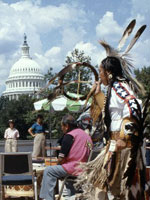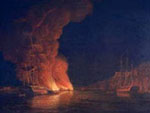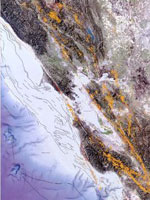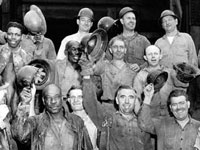Celebrate More Than St. Patrick
On March 17, the U.S. celebrates an Irish feast day with parades, food, drink, music, and the color green—but Irish immigrants, and their children, have given more to the U.S. than a spring holiday. Answer the questions below about notable Irish Americans.
1. Who was the first Irish American to run for president?
b. Alfred Emmanuel Smith, Jr.
 In 1928, Alfred Emmanuel Smith, Jr., four times governor of New York, ran as the Democratic candidate for president of the U.S.. Though "Al" Smith's heritage also included German, Italian, and English ancestry, he identified as Irish American, and faced prejudice for both his ethnicity and his religion (he was Catholic) during his campaign. The press and the public suspected him of drunkenness (stereotypically associated with Irish Americans), manipulation by the Pope, and involvement with Tammany Hall (a New York City Democratic political machine known for supporting Irish Americans in politics).
In 1928, Alfred Emmanuel Smith, Jr., four times governor of New York, ran as the Democratic candidate for president of the U.S.. Though "Al" Smith's heritage also included German, Italian, and English ancestry, he identified as Irish American, and faced prejudice for both his ethnicity and his religion (he was Catholic) during his campaign. The press and the public suspected him of drunkenness (stereotypically associated with Irish Americans), manipulation by the Pope, and involvement with Tammany Hall (a New York City Democratic political machine known for supporting Irish Americans in politics).
Smith lost the election to Herbert Hoover, but he went on to become president of Empire State, Inc.—the company that built the Empire State Building.
2. Which of the following men with Irish ancestry was known as "father" of a branch of the U.S. military?
a. John Barry, naval officer in the American Revolution
 Irish-born John Barry first crisscrossed the Atlantic as a respected commander of merchant ships—but when war broke out with England, he joined the Continental Army and was commissioned a naval captain in 1776. (He also served in several battles on land, while a ship he was to command, the Effington, was under construction.) Though he gained fame for valor and loyalty during the war, he returned to captaining merchant ships when it concluded.
Irish-born John Barry first crisscrossed the Atlantic as a respected commander of merchant ships—but when war broke out with England, he joined the Continental Army and was commissioned a naval captain in 1776. (He also served in several battles on land, while a ship he was to command, the Effington, was under construction.) Though he gained fame for valor and loyalty during the war, he returned to captaining merchant ships when it concluded.
However, in 1794, some time after the establishment of the U.S. Navy, President George Washington chose Barry as senior Captain of the Federal Navy. Barry saw active service until 1801, and trained many of the naval officers who would serve in the War of 1812. He was referred to as "Father of the U.S. Navy" in his own time.
3. Which famous survivor of the Titanic's sinking was Irish American?
d. Margaret Brown, activist and socialite
 The daughter of Irish immigrants, Margaret Brown rose into high-society circles when her husband, James Joseph Brown, became a board member of the Ibex Mining Company. She used her new social status to advocate for the rights of women and children—activities which she continued throughout her life. Her status also allowed her to board the Titanic as a first-class passenger; she earned fame and the nickname "The Unsinkable Molly Brown" for her efforts to get passengers into lifeboats and to bring her own lifeboat around to look for survivors.
The daughter of Irish immigrants, Margaret Brown rose into high-society circles when her husband, James Joseph Brown, became a board member of the Ibex Mining Company. She used her new social status to advocate for the rights of women and children—activities which she continued throughout her life. Her status also allowed her to board the Titanic as a first-class passenger; she earned fame and the nickname "The Unsinkable Molly Brown" for her efforts to get passengers into lifeboats and to bring her own lifeboat around to look for survivors.
4. Which of these women of Irish ancestry helped found the Industrial Workers of the World, a major (and still existing) labor union?
a. Mary Harris Jones
 Mary Harris Jones, also known as "Mother Jones," participated in the founding of the Industrial Workers of the World (IWW) in 1905. Jones, who was born in Ireland and grew up in the U.S., took a leading role in the early-20th-century labor movement following the death of her husband and four children in a yellow fever epidemic and the later loss of her dressmaking shop in the Great Chicago Fire. Arrested multiple times, she gained notoriety across the country as a labor organizer, motivating women and children to participate in strikes in support of their husbands and fathers. She also organized children to strike for their own rights—in 1903, child mill and mine workers marched in Jones's "Children's Crusade," helping to bring child labor to public attention.
Mary Harris Jones, also known as "Mother Jones," participated in the founding of the Industrial Workers of the World (IWW) in 1905. Jones, who was born in Ireland and grew up in the U.S., took a leading role in the early-20th-century labor movement following the death of her husband and four children in a yellow fever epidemic and the later loss of her dressmaking shop in the Great Chicago Fire. Arrested multiple times, she gained notoriety across the country as a labor organizer, motivating women and children to participate in strikes in support of their husbands and fathers. She also organized children to strike for their own rights—in 1903, child mill and mine workers marched in Jones's "Children's Crusade," helping to bring child labor to public attention.
Jones remained active in labor organization until her death in 1930, when she was over 90 years old.
For more on the first successfully-elected Irish American presidential candidate, try the John F. Kennedy Presidential Library and Museum. The organization offers primary and secondary sources and resources for both teachers and students.
To read a full history of John Barry's life and his service to the rebelling colonists and the young United States, try this article at ushistory.org, website of the Independence Hall Association.
Want to learn more about Molly Brown? If you live and teach near Denver, CO, you could visit her home, today the Molly Brown House Museum. If you don't live in Colorado, you can still read the website's overview of her life.
For more on Mary Harris "Mother" Jones, try Susan Campbell Bartoletti's book Kids on Strike! Eight chapters, illustrated with historical photographs, cover children in labor movements from the 19th century to the 20th, with one chapter devoted entirely to Jones's Children's Crusade. The Library Journal lists the book as appropriate to grades 5-8 and recommends it as a "fine resource for research as well as a very readable book."
- Bain News Service, "Al Smith," Library of Congress Prints and Photographs Collection (accessed January 13, 2010).
- Bain News Service, "Mrs. James J. 'Molly' Brown, survivor of the Titanic, three-quarter length portrait, standing, facing right, right arm on back of chair," 1890-1920 (accessed January 13, 2010).
- Bertha Howell, "'Mother' Jones -- #1," 1902, Library of Congress Prints and Photographs Collection (accessed January 18, 2010).
- John Barry Kelly, "Commodore Barry," 1995, ushistory.org (accessed January 13, 2010).
- Gilbert Stuart, Commodore John Barry, USN, c. 1801, Naval Historical Center (accessed January 13, 2010).
- United Press International, "Flag with shamrock flies above Fifth Ave. as Saint Patrick's Day Parade passes below, New York City," 1961, Library of Congress Prints and Photographs Collection (accessed July 18, 2010).





 On June 15, 1904, the General Slocum departed on the annual Sunday School excursion of St. Mark's German Lutheran Church. However, unbeknownst to passengers and crew, a fire had broken out in a storage room. Many passengers died of burns, and others drowned, unable to swim. The steamer's defective life preservers added to the death toll. The preservers' insides, made of finely-ground cork, quickly became waterlogged when the preservers' rotten covers fell away. One survivor told of a woman with three children. The mother and two girls could swim, but one daughter could not. The daughter was put in a life preserver and tossed overboard, where she immediately sank.
On June 15, 1904, the General Slocum departed on the annual Sunday School excursion of St. Mark's German Lutheran Church. However, unbeknownst to passengers and crew, a fire had broken out in a storage room. Many passengers died of burns, and others drowned, unable to swim. The steamer's defective life preservers added to the death toll. The preservers' insides, made of finely-ground cork, quickly became waterlogged when the preservers' rotten covers fell away. One survivor told of a woman with three children. The mother and two girls could swim, but one daughter could not. The daughter was put in a life preserver and tossed overboard, where she immediately sank. If you are curious about the Mary Celeste, one interesting online resource is "
If you are curious about the Mary Celeste, one interesting online resource is "

 1. Frederick Douglass: "The existence of slavery in this country brands your republicanism as a sham, your humanity as a base pretence, and your Christianity as a lie. It destroys your moral power abroad; it corrupts your politicians at home. It saps the foundation of religion; it makes your name a hissing, and a byword to a mocking earth. It is the antagonistic force in your government, the only thing that seriously disturbs and endangers your Union. It fetters your progress; it is the enemy of improvement, the deadly foe of education; it fosters pride; it breeds insolence; it promotes vice; it shelters crime; it is a curse to the earth that supports it; and yet, you cling to it, as if it were the sheet anchor of all your hopes. Oh! be warned! be warned! a horrible reptile is coiled up in your nation's bosom; the venomous creature is nursing at the tender breast of your youthful republic; for the love of God, tear away, and fling from you the hideous monster, and let the weight of twenty millions crush and destroy it forever!"
1. Frederick Douglass: "The existence of slavery in this country brands your republicanism as a sham, your humanity as a base pretence, and your Christianity as a lie. It destroys your moral power abroad; it corrupts your politicians at home. It saps the foundation of religion; it makes your name a hissing, and a byword to a mocking earth. It is the antagonistic force in your government, the only thing that seriously disturbs and endangers your Union. It fetters your progress; it is the enemy of improvement, the deadly foe of education; it fosters pride; it breeds insolence; it promotes vice; it shelters crime; it is a curse to the earth that supports it; and yet, you cling to it, as if it were the sheet anchor of all your hopes. Oh! be warned! be warned! a horrible reptile is coiled up in your nation's bosom; the venomous creature is nursing at the tender breast of your youthful republic; for the love of God, tear away, and fling from you the hideous monster, and let the weight of twenty millions crush and destroy it forever!" 2. Ida B. Wells: "The race problem or negro question, as it has been called, has been omnipresent and all-pervading since long before the Afro-American was raised from the degradation of the slave to the dignity of the citizen. It has never been settled because the right methods have not been employed in the solution. It is the Banquo's ghost of politics, religion, and sociology which will not down at the bidding of those who are tormented with its ubiquitous appearance on every occasion. Times without number, since invested with citizenship, the race has been indicted for ignorance, immorality and general worthlessness--declared guilty and executed by its self-constituted judges. The operations of law do not dispose of negroes fast enough, and lynching bees have become the favorite pastime of the South."
2. Ida B. Wells: "The race problem or negro question, as it has been called, has been omnipresent and all-pervading since long before the Afro-American was raised from the degradation of the slave to the dignity of the citizen. It has never been settled because the right methods have not been employed in the solution. It is the Banquo's ghost of politics, religion, and sociology which will not down at the bidding of those who are tormented with its ubiquitous appearance on every occasion. Times without number, since invested with citizenship, the race has been indicted for ignorance, immorality and general worthlessness--declared guilty and executed by its self-constituted judges. The operations of law do not dispose of negroes fast enough, and lynching bees have become the favorite pastime of the South." 3. Booker T. Washington: "The wisest among my race understand that the agitation of questions of social equality is the extremest folly, and that progress in the enjoyment of all the privileges that will come to us must be the result of severe and constant struggle rather than of artificial forcing. No race that has anything to contribute to the markets of the world is long in any degree ostracized. It is important and right that all privileges of the law be ours, but it is vastly more important that we be prepared for the exercise of these privileges. The opportunity to earn a dollar in a factory just now is worth infinitely more than the opportunity to spend a dollar in an opera-house."
3. Booker T. Washington: "The wisest among my race understand that the agitation of questions of social equality is the extremest folly, and that progress in the enjoyment of all the privileges that will come to us must be the result of severe and constant struggle rather than of artificial forcing. No race that has anything to contribute to the markets of the world is long in any degree ostracized. It is important and right that all privileges of the law be ours, but it is vastly more important that we be prepared for the exercise of these privileges. The opportunity to earn a dollar in a factory just now is worth infinitely more than the opportunity to spend a dollar in an opera-house." 4. Malcolm X: "If you don't take this kind of stand, your little children will grow up and look at you and think "shame." If you don't take an uncompromising stand--I don't mean go out and get violent; but at the same time you should never be nonviolent unless you run into some nonviolence. I'm nonviolent with those who are nonviolent with me. But when you drop that violence on me, then you've made me go insane, and I'm not responsible for what I do. And that's the way every Negro should get. Any time you know you're within the law, within your legal rights, within your moral rights, in accord with justice, then die for what you believe in. But don't die alone. Let your dying be reciprocal. This is what is meant by equality. What's good for the goose is good for the gander."
4. Malcolm X: "If you don't take this kind of stand, your little children will grow up and look at you and think "shame." If you don't take an uncompromising stand--I don't mean go out and get violent; but at the same time you should never be nonviolent unless you run into some nonviolence. I'm nonviolent with those who are nonviolent with me. But when you drop that violence on me, then you've made me go insane, and I'm not responsible for what I do. And that's the way every Negro should get. Any time you know you're within the law, within your legal rights, within your moral rights, in accord with justice, then die for what you believe in. But don't die alone. Let your dying be reciprocal. This is what is meant by equality. What's good for the goose is good for the gander." 6. Martin Luther King, Jr.: "There are those who still feel that if the Negro is to rise out of poverty, if the Negro is to rise out of the slum conditions, if he is to rise out of discrimination and segregation, he must do it all by himself. And so they say the Negro must lift himself by his own bootstraps. They never stop to realize that no other ethnic group has been a slave on American soil. The people who say this never stop to realize that the nation made the black man's color a stigma. But beyond this they never stop to realize the debt that they owe a people who were kept in slavery two hundred and forty-four years."
6. Martin Luther King, Jr.: "There are those who still feel that if the Negro is to rise out of poverty, if the Negro is to rise out of the slum conditions, if he is to rise out of discrimination and segregation, he must do it all by himself. And so they say the Negro must lift himself by his own bootstraps. They never stop to realize that no other ethnic group has been a slave on American soil. The people who say this never stop to realize that the nation made the black man's color a stigma. But beyond this they never stop to realize the debt that they owe a people who were kept in slavery two hundred and forty-four years." 7. W. E. B. Du Bois: "A saving remnant continually survives and persists, continually aspires, continually shows itself in thrift and ability and character. Exceptional it is to be sure, but this is its chiefest promise; it shows the capability of Negro blood, the promise of black men. Do Americans ever stop to reflect that there are in this land a million men of Negro blood, well-educated, owners of homes, against the honor of whose womanhood no breath was ever raised, whose men occupy positions of trust and usefulness, and who, judged by any standard, have reached the full measure of the best type of modern European culture? Is it fair, is it decent, is it Christian to ignore these facts of the Negro problem, to belittle such aspiration, to nullify such leadership and seek to crush these people back into the mass out of which by toil and travail, they and their fathers have raised themselves?"
7. W. E. B. Du Bois: "A saving remnant continually survives and persists, continually aspires, continually shows itself in thrift and ability and character. Exceptional it is to be sure, but this is its chiefest promise; it shows the capability of Negro blood, the promise of black men. Do Americans ever stop to reflect that there are in this land a million men of Negro blood, well-educated, owners of homes, against the honor of whose womanhood no breath was ever raised, whose men occupy positions of trust and usefulness, and who, judged by any standard, have reached the full measure of the best type of modern European culture? Is it fair, is it decent, is it Christian to ignore these facts of the Negro problem, to belittle such aspiration, to nullify such leadership and seek to crush these people back into the mass out of which by toil and travail, they and their fathers have raised themselves?" 7. Marcus Garvey: "Men and women of the white race, do you know what is going to happen if you do not think and act now? One of two things. You are either going to deceive and keep the Negro in your midst until you have perfectly completed your wonderful American civilization with its progress of art, science, industry and politics, and then, jealous of your own success and achievements in those directions, and with the greater jealousy of seeing your race pure and unmixed, cast him off to die in the whirlpool of economic starvation, thus, getting rid of another race that was not intelligent enough to live, or, you simply mean by the largeness of your hearts to assimilate fifteen million Negroes into the social fraternity of an American race that will neither be white nor black. Don't be alarmed! We must prevent both consequences. No real race loving white man wants to destroy the purity of his race, and no real Negro conscious of himself wants to die, hence there is room for an understanding and an adjustment, and that is just."
7. Marcus Garvey: "Men and women of the white race, do you know what is going to happen if you do not think and act now? One of two things. You are either going to deceive and keep the Negro in your midst until you have perfectly completed your wonderful American civilization with its progress of art, science, industry and politics, and then, jealous of your own success and achievements in those directions, and with the greater jealousy of seeing your race pure and unmixed, cast him off to die in the whirlpool of economic starvation, thus, getting rid of another race that was not intelligent enough to live, or, you simply mean by the largeness of your hearts to assimilate fifteen million Negroes into the social fraternity of an American race that will neither be white nor black. Don't be alarmed! We must prevent both consequences. No real race loving white man wants to destroy the purity of his race, and no real Negro conscious of himself wants to die, hence there is room for an understanding and an adjustment, and that is just."
